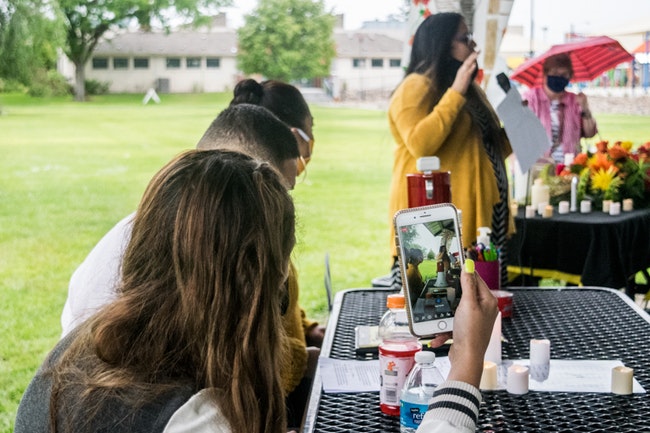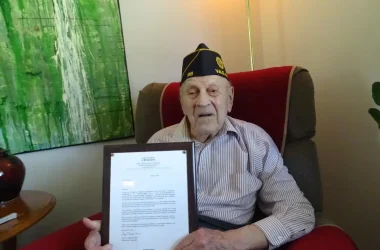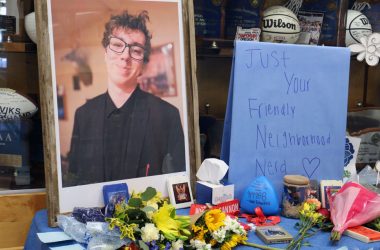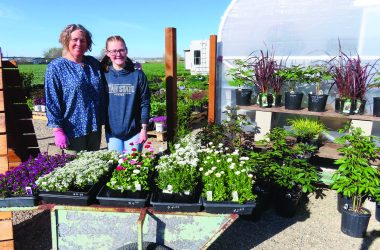
Black Lives Matter Ontario board member Raquel Sandoval-Gonzalez says while she now lives in Seattle, she is organizing in Ontario because she was born and raised in the town. (The Enterprise/Kezia Setyawan)
ONTARIO – Black Lives Matter Ontario is working with the city on its directional signs to ensure they accurately represent the ethnic groups that make up Ontario.
BLM Ontario members first heard discussion of the city’s ongoing wayfinding system project, which is the decorative signs that guide people throughout a city, including representation of different ethnic groups in Ontario when one of its board of directors, Jennifer Yano, sat in on one of Ontario’s Diversity Advisory Committee meetings. Raquel Sandoval-Gonzalez, who is on the BLM Ontario board, said that her group’s members then brought up their concerns that the groups weren’t being represented appropriately during subsequent conversations with Ontario City Manager Adam Brown.
The Boise design agency Trademark Design and Fabrication was hired by the city to work on the signs, said Brown. Trademark came up with the idea to “celebrate our cultural diversity here” by creating ethnically representative mosaics on some of the signs.
“Essentially, all these different triangles are kind of quilted together to form a really neat pattern that alludes to the history of the community,” said Brown.
The ethnic groups proposed for representation, Sandoval-Gonzalez said, were Mexicans, Native Americans, Basque and Japanese. But BLM Ontario members had an issue with a fifth group that was planned for the project — the “farmer, cowboy mosaic,” which represents “Western frontiersman culture,” said Brown.
“We immediately had some questions for the city manager and the city council,” said Sandoval-Gonzalez. “The cowboy option was the one that we were like, ‘OK, that’s not an ethnic group. That’s a job.’ So we narrowed it down to the four ethnicities that they had selected.”
It is unclear whether the city will keep the cowboy mosaic, but Brown said the discussion “made me think” and the concerns will be addressed once the ethnicity designs are submitted.
Sandoval-Gonzalez said members asked how Trademark came up with the proposed designs for each ethnic group, “and it turned out that they hadn’t really done a whole lot of research or hadn’t really incorporated local organizations in their research.”
“So we proposed to the city manager at our last meeting the different organizations that we could reach out to who might be able to at least, you know, say, ‘Yes, that’s a representative design’ or ‘No, that’s totally not in line with what the heritage or culture of those ethnicities is in this area,’” said Sandoval-Gonzalez.
Sandoval-Gonzalez said Black Lives Matter members suggested the city check the designs with the Hispanic Cultural Center of Idaho in Nampa for the Mexican mosaic, the Burns Paiute and Shoshone tribes for the Native American mosaic, the Ontario Basque Club for the Basque mosaic and the local Japanese American Citizens League for the Japanese mosaic.
However, she said Brown felt it would be best if BLM members reached out to the groups instead since they had been working with some of them, such as the Burns Paiute tribe, previously.
Now, Sandoval-Gonzalez and Yano are working on contacting each organization and getting feedback on the designs proposed by Trademark.
“And then if they are accurate, we’ll just let the city manager and Trademark know that they’re good to go,” said Sandoval-Gonzalez. “But if they’re not, I think the next step would be to connect [the organization] with Trademark and figure out what it is that would be more representative.”
Brown said when Trademark submitted the mosaic designs, the company sought feedback and were “excited to hear” that they would be getting it “directly from those populations.”
“I’m glad that BLM Ontario stepped up and not just wanted to complain about it, but wanted to actually help and provide some real feedback to it,” said Brown. “I think it’s going to add value.”
But Sandoval-Gonzalez said this project is just the “entry point” for BLM Ontario’s work to satisfy one of its original demands of the city council — to “purposefully seek Black and brown artists to be part of the [the city’s] Beautification section of the strategic plan and require artwork to represent the diversity in our community, including historic diversity.”
The organization’s demands, directed at the Ontario City Council and police department, were posted before the June 4 Ontario protest by organizer Charlie Gonzalez. The protest was one of thousands nationwide due to the killing of George Floyd, a Black man, by a white police officer in Minneapolis in late May.
The group’s other seven demands consisted of more diversity training for city officials, greater transparency in how the police department trains and reprimands officers, increasing community outreach programs in the police department and addressing the lack of gender diversity on the city council, among other things.
“Right now, we’re working on the one that we thought would be most achievable, easiest to deal with them,” said Sandoval-Gonzalez. “The beautification project was one that we felt like could be something we could immediately agree on.”
Sandoval-Gonzalez said their main goal is for the artwork to be historically accurate in representing the community, pointing to the murals around Vale as an example.
“We’d like to see representation of that sort, but that’s a little bit more accurate to the different people in the area,” said Sandoval-Gonzalez. “Where we have not the stories of the white settlers’ perspectives on paintings and buildings, but the stories of the different people who have lived in this area.”
Further, the group wants the artwork created to be done by artists of color since they would be “telling the stories of people of color.”
“We want somebody who’s going to not just be diverse, but also represent the people,” said Sandoval-Gonzalez.
News tip? Contact reporter Bailey Lewis at [email protected]
WE NEED YOUR SUPPORT TO REPORT VITAL NEWS….
Reader support allows the Enterprise to provide in-depth, accurate reporting that otherwise would not get done. Keeping the community well informed is essential. SUBSCRIBE – $5 a month, automatically. DONATE – to provide additional support.




